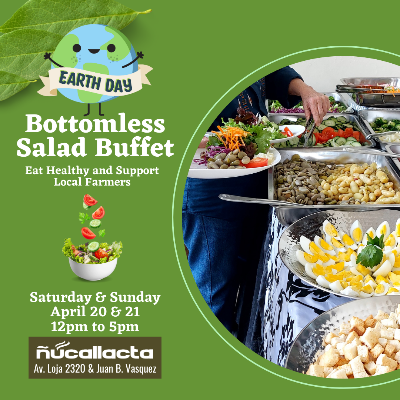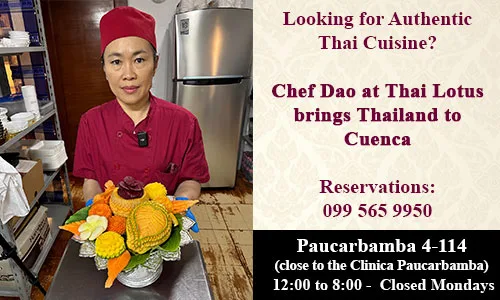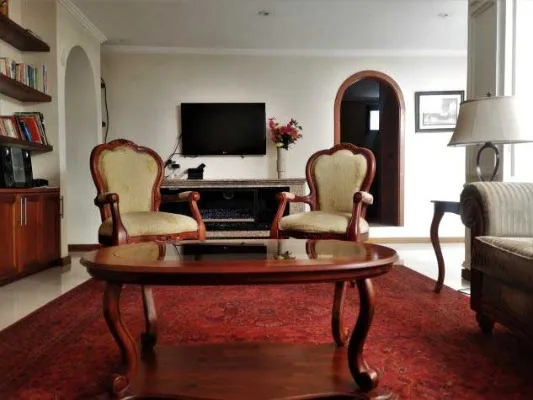The Cuenca almuerzo: You can get a good lunch for $2 but most expats don’t mind paying a little more
By Deke Castleman and Sylvan Hardy
The Spanish verb “to eat lunch” is almorzar. The noun is almuerzo (ahl-MWAIR-so). You notice the Arabic influence of the term in “al”; in addition, any Spanish spelling with a “z” in it is also a hand-me-down from the Arabic languages. Almuerzo has both.
The traditional almuerzo, also known as menu del día, is a fixed-price fixed-menu lunch, served from around 12:30 p.m. till around 3 p.m. in Ecuador. Traditionally, the almuerzo is the big meal of the day.

Typical Ecuadorian almuerzo.
Most offices and many stores close for two hours in the afternoon, the Latin custom of a leisurely lunch. In Cuenca, you won’t find too many people working through their lunch breaks, wolfing down fast food between customers or keystrokes. Here, there’s plenty of time to sit, eat slowly and breathe, relax, enjoy the other people at the table, digest, and get back to work without having a stroke. Many even go home to have lunch with their spouses and children.
As such, breakfast (desayuno) is usually light, with an egg or two, a roll or croissant with butter (mantequilla) or jam (mermelada), perhaps a couple slices of queso fresco (local medium-soft cheese), fresh fruit juice, and tea or coffee.
Supper (merienda) is also light, basically a snack, often a sandwich, although European and North American influences are adding calories to Ecuadorian dining habits.
Dinner (cena) is generally more formal and can be a big social meal, usually on weekends. It rarely starts earlier than 8:30 p.m. and sometimes continues into the wee hours.

A Cuban almuerzo.
Back to the almuerzo . . . there are endless variations on the theme. Many start with a bowl of popcorn, which goes great slathered in ají (the local salsa, make fresh daily from recipes that vary slightly family to family); others are launched with a bowl of mote (big kernels of white corn). Then comes six or eight ounces of fruit juice, usually fresh but sometimes more like coolaide, followed by a bowl of soup, usually potato-based, but sometimes lentil, quinoa, or corn (you might also see vegetable, chicken, or beef, though usually at the more expensive almuerzos). Some restaurants offer a choice of soup or salad.
The main plato (plate or entree) is some combination of rice, fries, avocado, patacones (fried slices of plantain), maybe a small salad or steamed vegetables, and a piece of beef or a chicken part, often in sauce.
Seco de pollo or carne (meaning that it’s served with rice) is also common.

A typical almuerzo main course at Meson Español on Luis Cordero. The meal also comes with soup or salad, a drink and dessert. All for $4.
Most almuerzos cost $2 to $4 and cater to working-class Cuencanos, along with students and retirees. Many of the restaurants in the almuerzo business have neither names nor signs and even fewer have menus, though some have chalkboards out front that list the fare of the day. You walk into the storefront of someone’s El Centro house, sit down, and the food starts arriving, often placed in front of you by a coming-of-ager in the family; you’ll see servers as young as 12, especially during school vacations.
Upscale lunches can cost $5 to $6.50. These cater to a expat and middle-class Ecuadorian clientele, the most popular options being Resto Maple on Gran Colombia and Tarqui and Cafe Austria on Hermano Miguel at Bolivar.
At these almuerzos típicos, “counting carbs” often means adding up all the different kinds of carbohydrates put in front of you on the plate, rather than how many calories of carbs you consume. For example, an almuerzo at a nameless signless menuless front-room restaurant near Feria Libre (the largest mercado in Cuenca) comes with five. This carbfest could fuel a marathon: soup with both potato and mote, then a lunch plate with rice, a fat patacone (fried plantain), and a tuna-casserole thing, with bits of tuna on mounds of spaghetti smothered in sauce.
For those new to the almuerzo tradition, here are some popular Cuenca options:
El Meson Español, Luis Cordero at Juan Jaramillo; Moliendo Cafe, Honorato Vasquez at Hermano Miguel; and El Rincon, Presidente Cordova at Luis Cordero; For an upscale almuerzos, ranging in price for $6 to $7, try Resto Maple, Gran Colombia at Tarque; Cafe Austria, Hermano Miguel at Simon Bolivar; and Pedregal Azteca at Estevez Toral at Bolivar.


















